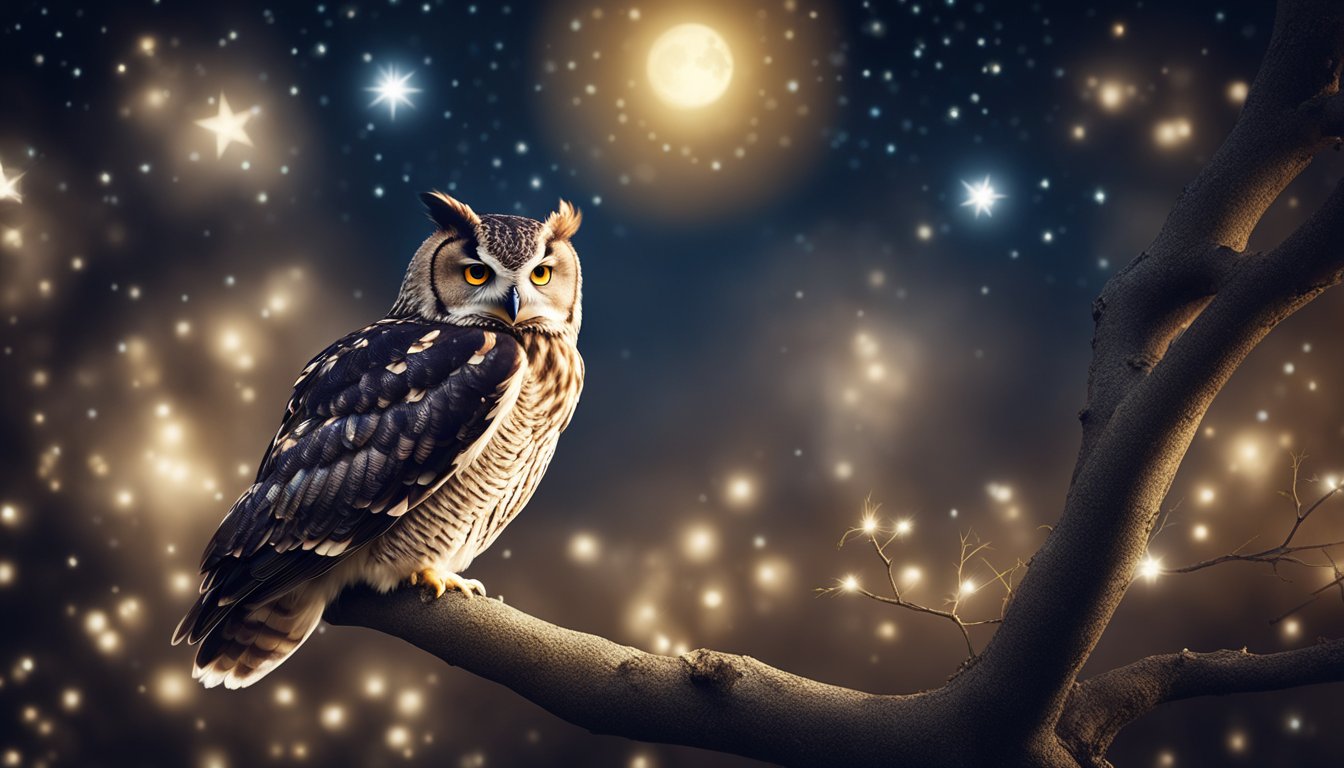Owls are the silent winged hunters of the night, known for their hushed flight and mysterious lives.
When we tuck ourselves into bed, these remarkable birds are just starting their day.
With their large, forward-facing eyes and swiveling heads, owls can spot a tiny mouse from afar and hear the softest rustle in the leaves.
It’s as if they have superpowers!
Imagine having the ability to see almost everything around you without moving your eyes—that’s an owl for you!

Did you know that not all owls hoot? That’s right! They can make a variety of sounds such as screeches, whistles, and even growls.
Owls use these sounds to talk to each other and to warn off any unwelcome guests from their territory.
Plus, their feathers are super special, designed to beat silently so they can sneak up on their food.
When we go on a nighttime nature walk, we might just be lucky enough to catch the soft whisper of owl wings above us.
We often picture owls as wise old birds, but there’s so much more to discover about them.
For instance, have you ever wondered why an owl can turn its head so far around?
It’s because they have extra neck bones that allow them to look over their shoulders and see what’s happening behind them—no need to turn their whole body.
It’s like having eyes in the back of your head!
Let’s embark on a journey together to unravel more secrets about these intriguing creatures of the night.
The Enigma of the Night’s Sky

When we look up at the nighttime sky, it’s not just stars we see, but a dramatic stage where owls play the leading roles.
Let’s explore these feathered mysteries together and unravel what happens when dusk falls.
Moonlit Hunters
Under the glow of the moon, our winged companions, the owls, take flight in search of their next meal.
With incredible vision that allows them to see in near darkness and silent wings, they glide nearly undetected.
The lunar light acts as a spotlight for these hunters, highlighting the terrain and revealing the rustling of a mouse or the movement of a rabbit.
Did you know that some owls can locate and catch their prey in complete darkness, guided only by their acute hearing? That’s right!
They can hear a mouse stepping on a twig from 75 feet away!
Starry Predators
Now, as for the stars, they have their own stories to tell in our nighttime saga.
As owls perch high in tree branches, their eyes are fixed on the ground, but the stars twinkle above.
These twinkling beacons have guided humans for centuries, but for our starry predators, they are the backdrop of their nightly hunt.
Owls use this celestial map less for navigation, since they have their home territories etched in their memories, but rather as part of the beautiful stage on which they perform each night.
And though they might seem like lone rangers of the dark, some owl species have been known to live in close proximity, forming a community of sky dancers, where the night unveils a bustling world.
Would you have guessed that these mysterious creatures are actually quite social at times?
So as we close our eyes and sleep, let’s remember the owls working hard to maintain the balance in our ecosystem, all under the vast, star-filled theater of the night sky.
Behaviors and Superstitions

Before we dive in, let’s remember that while owls are often shrouded in mystery, their behaviors are fascinating and their role in folklore is rich with symbolism.
Owls in Folklore
Traditionally, we find owls in the stories passed down through generations as symbols of wisdom and knowledge.
It’s not uncommon for us to see these magnificent birds representing a magical world where they act as guardians to secrets and sacred knowledge.
In many cultures, from ancient Greece to Native American tribes, the owl serves as a totem or spiritual guide.
For example, the Greek goddess Athena had the owl as her symbol, indicative of her connection to wisdom and the nocturnal bird.
Isn’t it astounding how these feathered creatures have captivated our ancestors’ imaginations?
Silent Flight Secrets
Have you ever wondered how owls can glide through the night without making a sound?
Unlike other birds, owls have special wing and feather adaptations that enable near-silent flight.
It’s due to the unique structure of their flight feathers, which have soft, comb-like edges that reduce turbulence and allow them to swoop down on their prey unheard.
This stealthy flight makes them skilled hunters in the still of the night. It’s as if they have their very own superpower!
Can you imagine being as stealthy as an owl during a game of hide and seek?
Owl Conservation: Protecting the Night Guardians

Our nights are brighter and safer thanks to our feathered friends, the owls.
They’re not just exciting to spot on a moonlit evening, they’re essential for maintaining the balance in our ecosystems.
To make sure these night guardians keep hooting happily, there are critical steps we take in conservation.
Habitat Preservation
When we talk about giving owls a home, we’re really talking about preserving the places they love—forests, grasslands, and even deserts.
By protecting large areas of land from development and pollution, we ensure owls have plenty of space to hunt, nest, and raise their owlets.
It’s like making sure we’ve got enough bedrooms for everyone in our family!
Deforestation is a big no-no for our owl pals. We’re working hard to halt the chainsaws and give trees a chance to stand tall.
After all, who wouldn’t want to live in a neighborhood full of beautiful, leafy trees?
Human-Owl Coexistence
Our relationship with owls can be a real hoot if done right.
We try to make our farms and neighborhoods welcoming for them, which means being mindful about how we interact with their habitats.
For instance, we’re super careful not to disturb their nesting sites, because a peaceful home is a happy home.
We also clamp down on the use of harmful pesticides that can make owls sick.
Instead, we encourage natural pest control—they’re expert mice catchers, after all!
When we understand and respect these magnificent creatures, living together becomes a breeze.
Let’s be the best neighbors we can be for our wise owl friends!
Frequently Asked Questions

Let’s unravel some of the mysteries of owls together, getting to know why these feathery friends are so fascinating!
Why do owls prefer to be active during the night instead of the day?
Owls have adapted to be active at night because it’s easier for them to sneak up on their prey and there’s less competition from other predators.
The cover of darkness is their secret weapon, allowing them to be expert hunters when most of their rivals are fast asleep.
How can owls see in the dark, and does it help them when they’re hunting for snacks?
Our owl pals have super-powered vision that allows them to see in the dark much better than we can.
Their large eyes can take in more light, and a special layer at the back of the eye reflects light back through the retina, giving them a second look at everything.
Yes, this incredible night vision is a big help when they’re swooping down on a tasty morsel!
What sorts of foods do owls munch on during their nocturnal adventures?
Depending on their species, owls feast on a variety of snacks.
Most of them love a good mouse or other small rodents, but some are known to dive for fish or even snatch other birds out of the skies.
Think of them as the ultimate midnight snackers, always on the lookout for their next treat.
Are all owls the same or do they come in different varieties, and how do we tell them apart?
Owls come in many shapes and sizes, from the minuscule Elf Owl to the imposing Great Horned Owl.
We tell them apart by looking at their size, color patterns, and unique features like ear tufts or facial discs.
It’s like they each have their own superhero costume!
Can owls turn their heads all the way around, and if so, how does that help them be sharp-eyed hunters?
Yes, owls can swivel their heads up to 270 degrees!
This rotating super skill means they can look in almost any direction without moving the rest of their bodies, making them silent observers that can spot potential snacks without startling them.
How do baby owls grow up and learn to be wise nocturnal navigators of the night sky?
Baby owls, or owlets, grow up under the watchful eyes of their parents. They start off fluffy and awkward, but soon learn to hunt and fly.
Their parents teach them everything from catching their first mouse to mastering the silent flight that will make them wise nocturnal navigators, just like their mom and dad.









